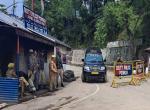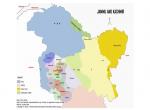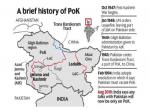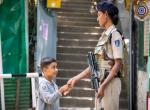Kashmir is relatively calm since the last couple of months. No street protests, no encounters between the militants and the security forces. Last encounter was reported on November 26 between the militants and the forces in Pulwama district of South Kashmir in which two militants were killed. Though ceasefire violation continue unabated on the Line of Control (LoC), the hinterland, however, is calm if not peaceful.
Since August 5, 2019 when the Parliament revoked the special status of the erstwhile state of Jammu and Kashmir and bifurcated the state into two Union Territories, there is undeniably decline in militancy related incidents. During the months of October and November, however, militants killed many civilians including fruit growers and forwarding agents, non-local labourers and truck drivers to enforce the shutdown and stop farmers from sending the fruit to outside market. Beyond that, the encounters between the forces and the militants have dropped sharply. Ostensibly, the argument is that since August 5 when Article 370 was scrapped, violence dropped because security forces remained focussed on maintaining law and order situation in the region. Even the security officials take the decline in militancy related violence at its face value. However, it needs a dispassionate analysis to understand the game plan.
The decline is strategic. Pakistan has asked the militants operating in Kashmir to go on hiding for the time being for two reasons. One; the Financial Action Task Force has forwarded a total of 150 queries mostly in regards to the actions taken by Pakistan against terrorism. Pakistan was supposed to submit the answers in this regard by January 8. It, however, submitted the compliance report on December 7, 2019, a month ahead of the deadline. The country continues to be on the grey list from the terror financing watchdog. The FATF is scheduled to meet in February in order to decide whether the country should be put on the blacklist or not. The country was put on the grey list last year in February 2019. Pakistan in its compliance report on December 7, gave a detailed account of the actions taken by its government against United Nations-terrorists groups as well as sentences handed to them by the courts.
Pakistan is trying hard that the watchdog extends the current deadline of complying to FATF's 27 action plans from February to June 2020 in its upcoming plenary review meeting as the current deadline is too short. The task force kept the country on its grey list for an extended period up to February 2020 and warned that Islamabad would be put on the blacklist if it did not comply with the remaining 22 out of 27 points related to anti-money laundering and counter-terrorist financing. It is in this backdrop, Pakistan has asked its terrorists networks in Kashmir to avoid contact with the security forces thereby not giving any reason to the watchdog to act against it.
At the same time ISI and Pakistani Army is desperately trying to push as many terrorists as it could to this side of LoC amid provocations on LoC and International Border. As the provocations on International Border or LoC does not come under the purview of FATF, giving Pakistan a strategic advantage to facilitate infiltration of terrorists to this side without the fear of any kind of reprimand from the international watchdog. Pakistan will thus continue to export terrorists even if that results in tensions on the borders.
Second, Kashmir after the abrogation of Article 370 is back on the global spotlight with western media, human rights advocates, and some world leaders particularly China, Turkey and Malaysia catapulting the “clampdown” against the international laws and covenants on human rights. Though, the attempts by Pakistan and its friends in the international community could not get the support for action against India, still Kashmir is a subject of debate internationally.
After about 52 years Kashmir is back on international agenda essentially because the response to August 5 events from international media and human rights organizations has been largely negative. Pakistan has clandestinely mobilized its Diaspora as well as the Kashmiri Diaspora to keep agitating on India’s action in Kashmir as long as they could. This attempt at internationalization of Kashmir by Pakistan is received well by the western media and human rights lawyers. Again at this point in time, Pakistan considers terrorist activities in Kashmir could be detrimental to its efforts of internationalizing the Kashmir issue. So the lull in Kashmir.
The year 2019 has certainly ended on a positive note and we hope 2020 will be peaceful. Now the question is whether the security agencies should simply wait or launch an offensive before the terrorists get a nod from Pakistan for carrying out attacks. The implicit claim that the action of August5, 2019 about voiding the special status of Jammu and Kashmir would lead to greater counterterrorism preparedness, should reflect on ground. The counterinsurgency grid is largely based on technical intelligence and of course, human intelligence has always been there. Since August 5, internet services across all platforms have been stopped in Jammu and Kashmir. This has honestly hampered the intelligence input to the security forces. That is precisely why encounters are not happening. Though the SMS service has been partially restored in Kashmir, one hopes the technical inputs from human sources flow which could help in trapping and targeting the terrorists.
Lack of communication with the informants needs to be addressed, sooner the better. It is quintessential that the security forces strike before terrorists are directed by Pakistan to heat up the theater. As of now, information flow about the terrorists is very limited. The security agencies deployed on ground need to enhance their intelligence grid before summer sets in. The important thing which needs to be highlighted is that there are no reports of new recruits joining the terrorists’ ranks from Kashmir. Only two boys from Zainapora area in Shopian district joined the militant ranks in last four or five months. They too were actually pushed to terrorism by a police officer placed there. The officer reportedly tortured the duo for extortion. Otherwise, there are absolutely no reports from any corner of Kashmir valley about fresh recruitment taking place in militant ranks.
The problem, however, remains the interaction of the hardcore militants on hiding with the local youth. Usually during winters, militants could not build shelters in field or woods because of the freezing temperatures. They are pushed back to habitations. Here, they come in contact with youth. The contact between the militants and gullible youth produces a long chain of sleeper cells and over ground workers. This is problematic. Rather than waiting for the summers to set in the security forces should activate their sources both human and technical to chase the hiding militants. They have to be on run. The forces cannot afford to give militants a breather.
But the problem, again is that the sources have dried up for two reasons. One; as already mentioned, they are not able to pass on the information because internet is not functional. Second but most importantly, the human sources are always vulnerably placed. They are the softest targets if exposed. The security forces should be able to protect them.
What is worrisome, however, is while the gun battles have declined militants have become active in Srinagar city and outskirts. According to police sources, the movement of militants in the city has also increased following Article 370 revocation. Over Ground Workers were involved in many incidents of grenade throwing in Srinagar city during the months of October, November and even December to enforce shutdown. Though the police and security agencies have intensified the vigil and security has been particularly beefed up across Srinagar city, they are yet to demolish the modules.
One important observation is that overwhelming majority disapprove terrorism but no one is ready to express his or her views publicly. Even elders in families hesitate denouncing terrorism in front of the youngsters. This has hugely impacted the psyche of the younger generation in Kashmir. Notwithstanding the indoctrination by the extremist religious organizations, silence of the silent majority is seen as approval for the violence. Romanticisation of terrorists during last four or five years is also reflected in the outlook of younger generation.
The August 5 decision of doing away with the special status of erstwhile state of Jammu and Kashmir provides an opportunity to reveal the inside truth. Policy makers and researchers should find answers to the question on how the people denouncing violence in all its manifestations can speak their heart.
(The paper is the author’s individual scholastic articulation. The author certifies that the article/paper is original in content, unpublished and it has not been submitted for publication/web upload elsewhere, and that the facts and figures quoted are duly referenced, as needed, and are believed to be correct). (The paper does not necessarily represent the organisational stance... More >>
Image Source: https://akm-img-a-in.tosshub.com/indiatoday/images/story/201908/kashmir-tweet-photoshop_0-770x433.jpeg?HPfpGxaBrURKE4DLfGT4afxu6WS6WDXk










Post new comment